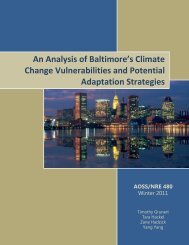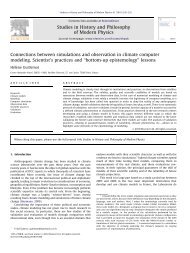Lal, Carbon Sequestration, PhilTransRoySoc 2008
Lal, Carbon Sequestration, PhilTransRoySoc 2008
Lal, Carbon Sequestration, PhilTransRoySoc 2008
Create successful ePaper yourself
Turn your PDF publications into a flip-book with our unique Google optimized e-Paper software.
Downloaded from rstb.royalsocietypublishing.org on April 14, 2010<strong>Carbon</strong> sequestration R. <strong>Lal</strong> 817atmosphericC pool =760 Pg(+3.5 Pg yr –1 )hidden C costs of inputof wetlandsdrainigerosionacceleratedbiomass burningcultivationsoildeforestationTerrestrial ecosystems have been the source ofatmospheric CO 2 ever since the dawn of settledagriculture 10000 years ago, and of CH 4 sincethe domestication of cattle and cultivation ofrice paddies about 5000 years ago. Totalamount of C emitted by terrestrial ecosystemsis estimated at 320 Pg in the pre-industrial eraand 136 Pg since 1850. Of the 136 Pg, 78 Pg isemitted from world soils consisting of 26 Pgfrom erosion and 52 Pg from mineralization.Increasing atmospheric CO 2 concentration willenhance NPP by CO 2 fertilization effect.Restoration of degraded ecosystems andcoupling of C with N and P cycles alsoenhances the terrestrial C pool.carbonrestorationcoupling of C with N and P cyclesdioxidefertilizationecosystemsof degradedterrestrial C Pool =3060 Pg+ 2–4 Pg C yr –1(i) SOC = 1550 Pg(ii) SIC = 750 Pg(iii) biotic pool = 560 Pg(–1.6 Pg yr –1 )Figure 2. The atmospheric C pool is increasing at the rate of 3.5 Pg C yr K1 . The terrestrial C pool contributes approximately1.6 Pg C yr K1 through deforestation, biomass burning, draining of wetlands, soil cultivation including those of organic soils,accelerated erosion and hidden C costs of input (e.g. fertilizers, tillage, pesticides, irrigation). Terrestrial C pools are presentlysink of 2–4 Pg C yr K1 . Conversion to a judicious land use and adoption of recommended practices in managed ecosystems canmake these important sinks especially due to CO 2 fertilization effects.from fossil fuel consumption to the atmosphere.The rate of fossil fuel consumption may peak byabout 2025.The terrestrial and atmospheric C pools are stronglyinteracting with one another (figure 2). The annual rateof photosynthesis is 120 Pg C, most of which isreturned back to the atmosphere through plant andsoil respiration. The terrestrial C pool is depleted byconversion from natural to managed ecosystems,extractive farming practices based on low externalinput and soil degrading land use. The pedologic poolloses 0.4–0.8 Pg C yr K1 to the ocean through erosioninducedtransportation to aquatic ecosystems. Theterrestrial sink is presently increasing at a net rate of1.4G0.7 Pg C yr K1 . Thus, the terrestrial sink absorbsapproximately 2–4 Pg C yr K1 and its capacity mayincrease to approximately 5 Pg C yr K1 by 2050(Cramer et al. 2001; Scholes & Noble 2001). Increasein the terrestrial sink capacity may be due to CO 2fertilization effect and change in land use and management.The biotic pool also contributes to increase inatmospheric CO 2 concentration through deforestationand biomass burning.3. CARBON SEQUESTRATIONEmission rates from fossil fuel combustion increasedby 40% between 1980 and 2000 (Wofsy 2001). Yet,the amount of CO 2 accumulating in the atmosphereremained the same over this period because the excessCO 2 released is being removed by oceans, forests, soilsand other ecosystems (Battle et al. 2000). AtmosphericCO 2 increased at a rate of 2.8–3.0 Pg C yr K1 duringthe 1980s and 1995, and between 3.0 and3.5 Pg C yr K1 during 1995–2005. Considering thetotal anthropogenic emissions of between 6 and8PgCyr K1 , while the atmospheric increase has beenPhil. Trans. R. Soc. B (<strong>2008</strong>)




